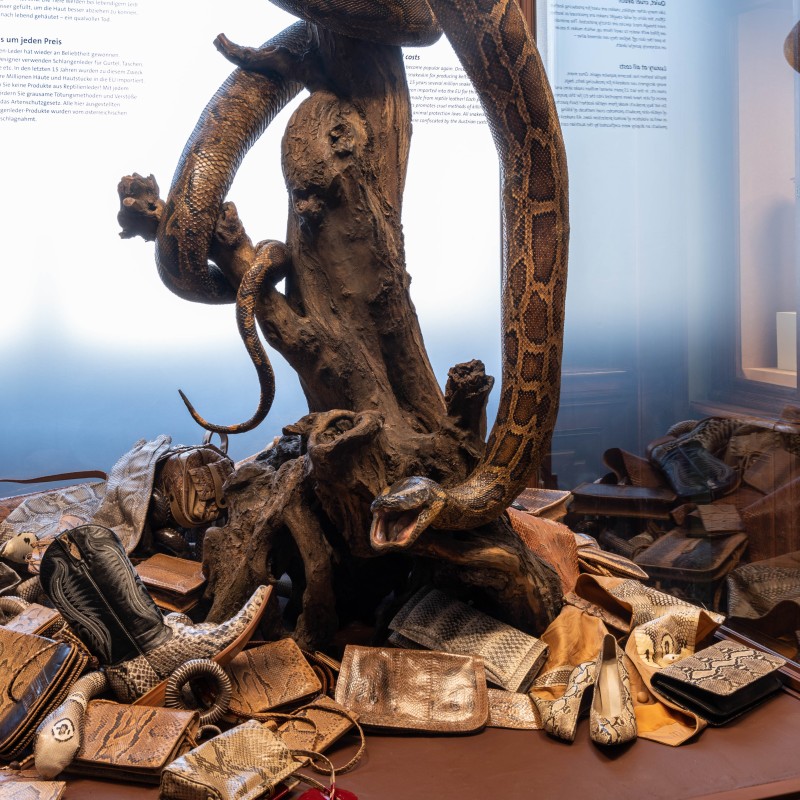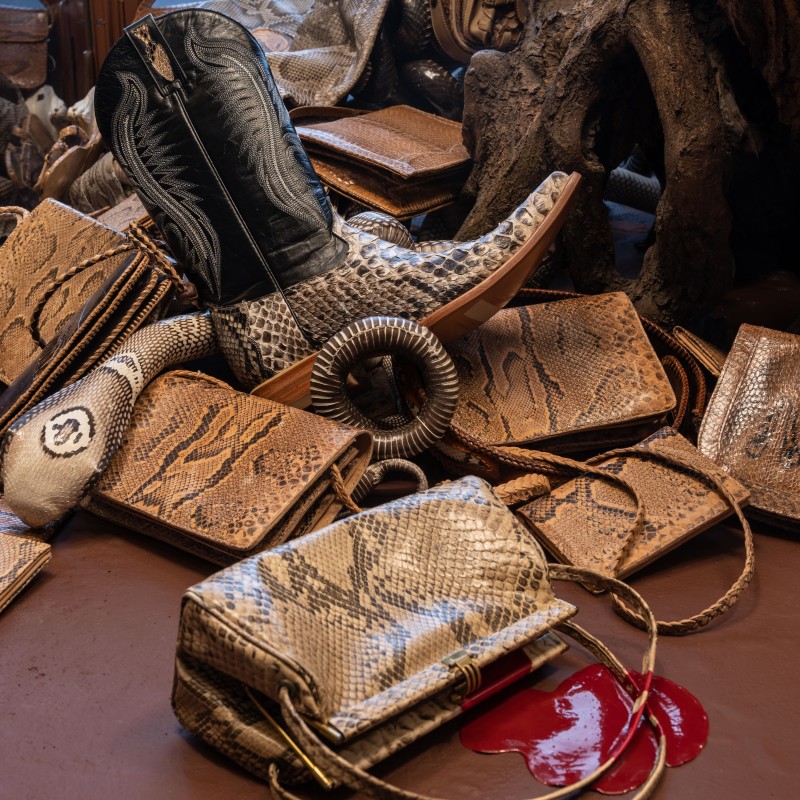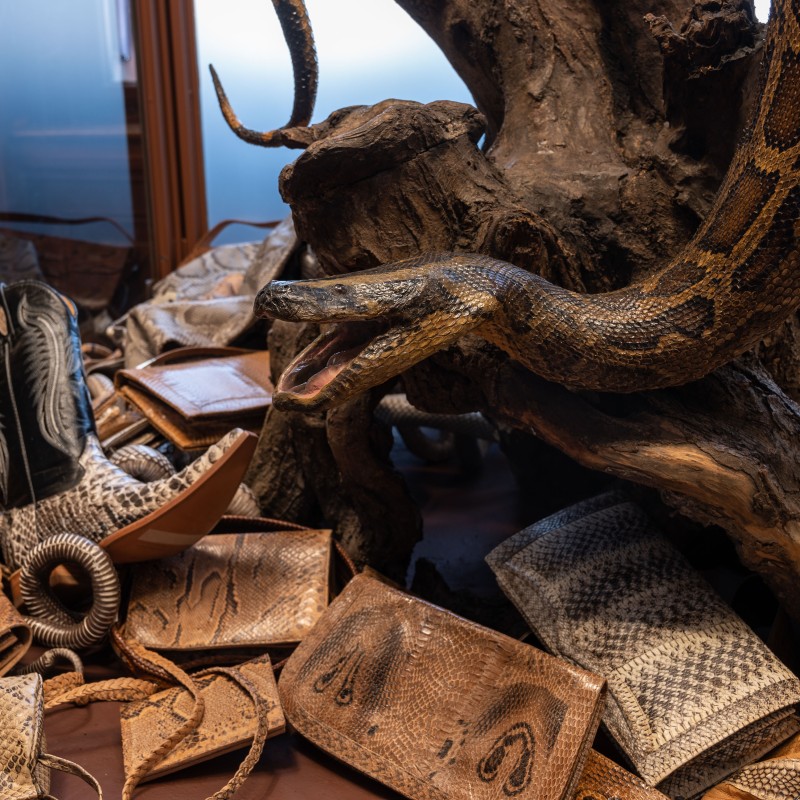New area on species conservation at the Natural History Museum Vienna
19. January 2021
A newly designed display case on the first floor of the NHM Vienna addresses the urgent issue of species conservation, with
a particular focus on reptiles. Snakes and many other reptiles are used to make leather. The animals are often caught in the
wild – despite the fact that most snake species are strictly protected. This new exhibition area aims to help raise awareness
about the importance of protecting these species.
Snakeskin products are often the result of a cruel
process – in many cases using snakes killed illegally despite their protected status. The animals are then filled with water
while still alive to make it easier to peel off their skin, before being skinned alive and suffering a slow, agonizing death.
"Reptile leather is back in fashion. Many designers today are using snakeskin for belts, bags and shoes. Over the last 15 years, several million full and partial skins have been imported into the EU for this purpose. All the snakeskin products on display in our case have been confiscated by Austrian customs or donated to the Natural History Museum Vienna," says curator Dr Silke Schweiger, head of the museum’s Herpetological Collection.
Alongside many snakeskin products on show in the display case visitors will also find a Burmese python (Python bivittatus). The commercial exploitation of the Burmese python for the leather industry has had a significant impact on population numbers in many Southeast Asian countries. Until the 1970s the Burmese python was a relatively common sight in Thailand, Laos, Cambodia, and Vietnam. In the years that followed, however, this species became increasingly popular for use in the leather industry. Trade restrictions imposed by Thailand to protect the Burmese python allowed the population to recover in some parts of the country by 2003, and the snakes were seen more frequently once again. Indonesia also awarded the Burmese python protected status in 1978. Since then, no export permits have been issued by Indonesia for the trade in Burmese python skins.
In Laos, Cambodia and Vietnam, however, the snakeskin industry continues to flourish. It is these countries which are largely responsible for the decline in the Burmese python population. Deforestation, forest fires, soil erosion, agricultural expansion and growing populations also play their part in reducing the snake’s natural habitat, which may ultimately result in it becoming extinct. Today the Burmese python is considered in need of protection, is subject to export restrictions, and is classified as an endangered species.
The newly designed display case has been on show in Hall 27 since mid-January 2021 and will be open to visitors after the end of the Covid-19 lockdown. The five-meter-long Burmese python from Java (Southeast Asia) has been part of the NHM Vienna collection since around 1900. In addition to this giant snake, the display also features countless products made of snakeskin such as stuffed cobras, wallets, trousers, shoes, and bags. Visitors are discouraged from buying products made from reptile skin – each purchase promotes cruel killing methods and violates the Endangered Species Act.
The NHM Vienna’s Herpetological Collection comprises around 220,000 exhibits preserved in alcohol as well as 6,000 dry specimens. Over the course of more than 200 years, scientists at the museum have endeavored to expand and research the collection and have written countless publications.
"Reptile leather is back in fashion. Many designers today are using snakeskin for belts, bags and shoes. Over the last 15 years, several million full and partial skins have been imported into the EU for this purpose. All the snakeskin products on display in our case have been confiscated by Austrian customs or donated to the Natural History Museum Vienna," says curator Dr Silke Schweiger, head of the museum’s Herpetological Collection.
Alongside many snakeskin products on show in the display case visitors will also find a Burmese python (Python bivittatus). The commercial exploitation of the Burmese python for the leather industry has had a significant impact on population numbers in many Southeast Asian countries. Until the 1970s the Burmese python was a relatively common sight in Thailand, Laos, Cambodia, and Vietnam. In the years that followed, however, this species became increasingly popular for use in the leather industry. Trade restrictions imposed by Thailand to protect the Burmese python allowed the population to recover in some parts of the country by 2003, and the snakes were seen more frequently once again. Indonesia also awarded the Burmese python protected status in 1978. Since then, no export permits have been issued by Indonesia for the trade in Burmese python skins.
In Laos, Cambodia and Vietnam, however, the snakeskin industry continues to flourish. It is these countries which are largely responsible for the decline in the Burmese python population. Deforestation, forest fires, soil erosion, agricultural expansion and growing populations also play their part in reducing the snake’s natural habitat, which may ultimately result in it becoming extinct. Today the Burmese python is considered in need of protection, is subject to export restrictions, and is classified as an endangered species.
The newly designed display case has been on show in Hall 27 since mid-January 2021 and will be open to visitors after the end of the Covid-19 lockdown. The five-meter-long Burmese python from Java (Southeast Asia) has been part of the NHM Vienna collection since around 1900. In addition to this giant snake, the display also features countless products made of snakeskin such as stuffed cobras, wallets, trousers, shoes, and bags. Visitors are discouraged from buying products made from reptile skin – each purchase promotes cruel killing methods and violates the Endangered Species Act.
The NHM Vienna’s Herpetological Collection comprises around 220,000 exhibits preserved in alcohol as well as 6,000 dry specimens. Over the course of more than 200 years, scientists at the museum have endeavored to expand and research the collection and have written countless publications.




